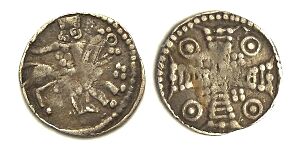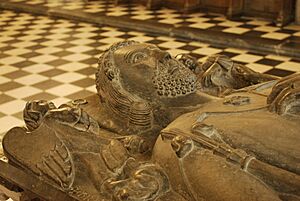Henry I, Duke of Brabant facts for kids
Quick facts for kids Henry I |
|
|---|---|
| Duke of Brabant Duke of Lothier |
|
 |
|
| Denier 'au cavalier' with Duke Henry galloping to right; struck in Antwerp after 1210 | |
| Spouse(s) | Matilda of Boulogne Marie of France |
| Issue | |
| Maria of Brabant, Holy Roman Empress Adelaide Margaret Matilda Henry II, Duke of Brabant Godfrey Elizabeth Marie |
|
| Noble family | House of Reginar |
| Father | Godfrey III, Count of Leuven |
| Mother | Margaret of Limburg |
| Born | c. 1165 |
| Died | 5 September 1235 Cologne, Kingdom of Germany, Holy Roman Empire |
| Burial | St. Peter's Church, Leuven |
Henry I (also known as "The Courageous") was a very important leader from the House of Reginar family. He was the first ever duke of Brabant, ruling from around 1183 until he passed away in 1235.
Contents
Henry's Early Life
Henry was born around 1165, possibly in a city called Leuven (which is in modern-day Belgium). His father was Count Godfrey III, who held several important titles like Duke of Lower Lorraine. His mother was Margaret of Limburg.
From a young age, Henry helped his father rule. In 1180, he married Matilda of Boulogne. As a wedding gift, his father gave him the County of Brussels. Henry even acted as a temporary ruler (called a regent) when his father went on a long trip to Jerusalem between 1182 and 1184.
Becoming a Duke and Expanding Power
In 1183, Henry officially became the Duke of Brabant. When his father died in 1190, the German King Henry VI confirmed this new title. However, the King also made the older Duchy of Lower Lorraine a less important title.
Duke Henry wanted to make his own lands bigger and stronger. This often led to disagreements with other powerful counts, like Baldwin V of Hainaut. He also had problems with the German King when his brother, Albert, was chosen as a bishop and then sadly murdered.
Adventures in the Crusades
Henry also had conflicts with other dukes and counts in the region. But in 1197, he joined the Crusade of Henry VI. This was a big religious war to take back lands in the Middle East.
In October of that year, Henry helped capture the city of Beirut. He then planned to go to Jaffa with other crusaders. However, he heard that the King of Jerusalem had died, so he went back to Acre. There, he became the temporary ruler until a new king arrived.
Later, from 1217 to 1218, Duke Henry joined another big religious journey, the Fifth Crusade, which went to Egypt.
Politics and Battles in Europe
After the emperor's death in 1197, Duke Henry supported a candidate named Otto IV to become the new emperor. Otto was going to marry Henry's daughter, Maria. Henry fought against Otto's rivals.
However, in 1204, Henry changed his mind and supported Philip of Swabia instead. After Philip was assassinated in 1208, Henry was even suggested as a possible successor for the throne! Eventually, he made peace with Emperor Otto IV. They fought together against King Philip II of France in the 1214 Battle of Bouvines, but they lost.
In 1213, Duke Henry also suffered a big defeat against the Bishopric of Liège in the Battle of Steppes. In 1234, he took part in another military campaign called the Stedinger Crusade.
Building New Towns
Duke Henry I was very interested in developing towns and cities. He focused on areas where he could expand his power. He often created new towns or gave existing ones special rights and trade benefits. This helped to organize and strengthen his lands.
Two important towns that received city rights and trade privileges from Duke Henry were 's-Hertogenbosch and Eindhoven.
Henry's Family and Children
Henry had many children. With his first wife, Mathilde of Boulogne, he had six children:
- Maria (born around 1190), who married two different important leaders.
- Adelaide (born around 1190), who also married several times.
- Margaret (1192–1231), who married Count Gerhard III.
- Mathilde (born around 1200), who married two different counts.
- Henry II of Brabant (1207–1248), who would become the next Duke.
- Godfrey (1209–1254), who became Lord of Gaesbeek.
Henry's second marriage was in 1213 to Marie, who was the daughter of King Philip II of France. They had two children:
- Ysabeau (Elizabeth) (died 1272), who married two different counts.
- Marie, who sadly died when she was young.
Henry's Death and Burial Place
In 1235, Henry I was given an important job by the German emperor Frederick II. He was asked to travel to England and bring the emperor's future wife, Isabella, back to Germany.
However, Henry became ill on his way back and passed away in Cologne. He was buried in Saint Peter's Church in Leuven. You can still see his tomb there today.
Henry's Tomb and Its History
Henry I's tomb in Saint Peter's Church in Leuven is the oldest one of its kind that still exists. The image of Henry on the tomb looks like a young, smiling man. He is shown lying on a tall base, wearing a long robe and a duke's cloak, and holding a scepter. Two angels are shown waving incense near his head.
Originally, Henry's tomb was placed right at the church's altar. This was a special honor usually given only to very important families and church leaders. The church itself was rebuilt in the 1400s, changing from a Romanesque style to a Gothic one. During this time, Henry's grave was moved to a place of honor in front of the main altar.
Sadly, during the French occupation in the 1700s, the grave was damaged. Its remains were buried under the church tower. It wasn't until the mid-1800s that the monument was fixed and moved to a different chapel. Henry's bones were dug up in 1929. They were finally put back into the tomb in 1998. Today, the monument is back in its original special spot, in front of the high altar.
See also
- Dukes of Brabant family tree
Sources
- Chronique des Ducs de Brabant, Adrian van Baerland, Antwerp (1612).
|
Henry I, Duke of Brabant
House of Reginar
|
||
| Regnal titles | ||
|---|---|---|
| Preceded by Godfrey III of Leuven as duke of Lower Lorraine and landgrave of Brabant) |
Duke of Lothier 1190–1235 |
Succeeded by Henry II |
| Duke of Brabant 1183/1184–1235 |
||



